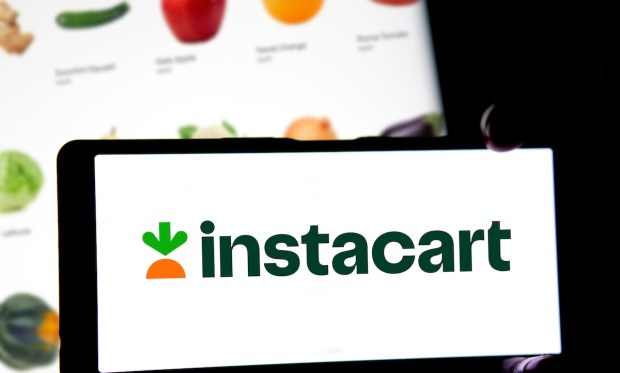
Instacart is seeing in-store technologies impact grocery shoppers’ spending and loyalty.
The aggregator’s CEO, Fidji Simo, noted in a letter shared with investors Wednesday (May 8) discussing its first-quarter 2024 earnings results that, according to merchants who have deployed the company’s Caper Cart smart self-checkout shopping carts, “people are seeking out stores” that offer the technology, including shoppers who are new to the merchant.
“We made an early bet that smart carts would be the winning technology for transforming the in-store grocery experience because it’s a form factor people recognize and it doesn’t require retrofitting a whole store with large capex investments,” Simo said in the letter. “Our Caper Carts do so much more than allow people to skip checkout. The digital screen makes shopping more personalized and delightful.”
Additionally, the grocery technology platform shared insights from grocer Schnucks that these shopping carts drive up average basket size.
Many consumers are integrating technologies into their in-store journeys, according to data from the PYMNTS Intelligence study “2024 Global Digital Shopping Index: U.S. Edition,” created in collaboration with Visa Acceptance Solutions. The report, which drew from a survey of more than 2,400 United States consumers, found that approximately 20% of consumers surveyed prefer to shop in stores with the assistance of digital technologies.
Merchants, for their part, believe that self-service technology is key to shopper loyalty. PYMNTS Intelligence’s “Big Retail’s Innovation Mandate: Convenience and Personalization” revealed that 61% of grocers thought consumers would be very or extremely likely to switch merchants if not offered self-service kiosks.
Regarding the smart carts, Simo noted in the letter that screens “will soon be equipped with real-time offers based on your location within a store, what’s already in your basket, and your personal preferences.” Personalization is already driving conversion for the aggregator, with Simo highlighting a statistic that in the quarter, 75% of Instacart customers purchased at least one item from a personalized prompt to consider a previously bought item.
Consumers want this kind of targeted experience. The PYMNTS Intelligence report “Personalized Offers Are Powerful — but Too Often Off-Base,” which drew on responses from more than 2,500 U.S. consumers, found that 83% of shoppers were interested in receiving personalized offers.
According to Instacart, shoppers on the platform tend to prefer to make purchases from multiple merchants, rather than staying loyal to just one or two. The aggregator noted in the letter that its average customer has made purchases from more than five retailers via its marketplace and that members of its paid Instacart+ membership program make purchases from “more than twice as many” merchants as those who are not part of the program.
According to PYMNTS Intelligence’s 2022 report, “Decoding Consumer Affinity: The Customer Loyalty To Merchants Survey 2022,” it seems that online grocery shoppers are actually more loyal to merchants than brick-and-mortar shoppers, however. The report revealed that 36% of online grocery customers have shopped with three or more merchants, while 48% of in-store customers said the same.
Overall, in the quarter, Instacart saw 9% year-over-year growth in orders and an 8% rise in total revenue.
Instacart cited convenience as consumers’ top reason for making purchases via the platform, noting that there has been a shift over the last seven years away from orders in advance toward those placed for on-demand delivery.
Now, the aggregator is looking to capture consumers’ restaurant ordering loyalty in addition to their grocery loyalty. Through a new partnership with Uber, Instacart customers will be able to order from a range of restaurants on its platform through a new “Restaurants” tab, enabled by Uber Eats.
“Simply put, no other marketplace offers the leading customer experience we provide at the scale and competitive cost we deliver it at,” Simo told analysts on a call Wednesday. “And now, by partnering with Uber, we’re giving people more of what they’re looking for. By bringing on hundreds of thousands of restaurants to Instacart overnight, we’re creating an unmatched combination of grocery and restaurant options for Instacart customers.”